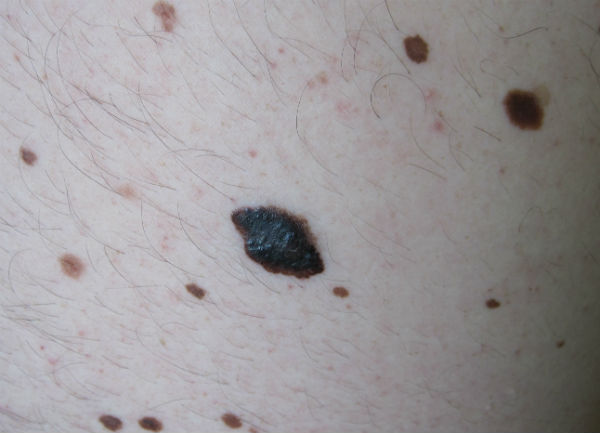Melanoma is one of the most potentially aggressive forms of skin cancer. I say “potentially” because if detected early, it has a very high survival rate, whereas if diagnosed “late,” it can have fatal consequences. However, its appearance is not so alarming, as it can simply be a “strange spot” on the skin.

It usually appears as an ugly brown or blackish spot or lump that can take different shapes and sometimes ulcerates. Its colors, edges, and shape are irregular, and it can contain different shades of brown. In addition to the photos in this post, here you can see many other images of melanoma, where you can observe the varied appearance it can have.

The incidence of melanoma is increasing, probably due to earlier detection, thanks to awareness campaigns and dermatoscopy. However, despite advances in medicine, it has not been possible to reduce its mortality rate.
Despite scientific advances, it has not been possible to reduce the mortality rate of melanoma.
Its frequency increases with age. It is the 5th most common cancer in men and the 7th in women, with an incidence of 6.14 in men and 7.26 in women per 100,000 inhabitants. In Europe, around 60,000 new cases are diagnosed each year.
Melanoma can appear anywhere on the body, although it is more common on the trunk and head in men and on the extremities in women.
RISK FACTORS FOR MELANOMA
Scientific studies have shown that there are certain physical characteristics or behaviors that increase the risk of developing melanoma:
- Having a family member who has had melanoma.
- Having atypical nevi. Atypical nevi are moles with a number of characteristics that make them more “disturbing.” It is very difficult to explain this in a post, so when in doubt, it is best to see a dermatologist.
- Having a large number of moles (>25).
- Intense sun exposure: it has been shown that people who have been exposed to the sun throughout their lives (for work or leisure) are at greater risk. Sporadic and intense exposure (spending long hours in the sun during the summer) and sunburn before the age of 18 have been shown to be particularly important.
- Use of sunbeds before the age of 35.
- Certain physical characteristics such as very fair skin, abundant freckles, light-colored eyes, or blond/red hair.
The probability that a changing mole or spot is melanoma is very low, but considering the consequences, it is best to ask if you have any doubts, no matter how silly they may seem.
If you have any of these factors, it is advisable to have regular check-ups with a dermatologist. If not, always remember to consult a doctor if you notice any changes in a mole (according to the ABCDE rule) or the appearance of any new spots that look “strange.” The probability that this change in a mole or new spot is actually melanoma is very low, as it is not a common cancer, but considering its possible consequences (which can lead to death), do not hesitate to ask if you have even the slightest doubt (that’s what we’re here for ;).
To conclude, another recommendation: protect yourself from the sun. We will talk about this in other posts.…
